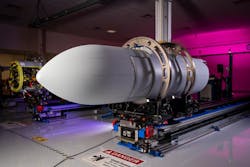Raytheon to build three midband airborne electronic warfare (EW) jammers for Navy EA-18G Growler aircraft
PATUXENT RIVER NAS, Md. – Airborne electronic warfare (EW) experts at Raytheon Technologies Corp. will build three advanced electronic jammers for U.S. Navy EA-18G Growler EW jets under terms of a $171.6 million contract announced Friday.
Officials of the Naval Air Systems Command at Patuxent River Naval Air Station, Md., are asking the Raytheon Intelligence and Space segment in El Segundo, Calif., to build three Next Generation Jammer NGJ) midband (NGJ-MB) low-rate initial production lot-one ship sets.
The NGJ midband is an advanced electronic attack system that denies, disrupts, and degrades enemy communications and air-defense radar systems. It is built with a combination of agile active electronically scanned arrays (AESA) and an all-digital back end.
The NGJ-MB helps the Growler aircraft operate at long ranges, attack several different targets simultaneously, use advanced electronic jamming techniques, and incorporate rapid upgrades through a modular, open systems architecture.
Raytheon delivered the first NGJ-MB pod to the Navy for testing in July 2019. The technology can also be scaled to other missions and aircraft.
The NGJ is a tactical electronic jammer pod that replaces the 40-plus-year ALQ-99 jammer system on the EA-18G -- a version of the Navy's carrier-based two-seat F/A-18F Super Hornet jet fighter-bomber that is modified specially for electronic warfare.
The EA-18G leads an airborne attack by disrupting enemy radar, communications, and computer networks with jamming signals and computer viruses. The aircraft also can destroy enemy radar installations with its AGM-88 High-speed Anti-Radiation Missiles (HARM).
Raytheon's NGJ will integrate the most advanced electronic attack technology into the EA-18G, such as high-powered, agile beam-jamming techniques, and solid-state electronics to deny, degrade and disrupt enemy threats while protecting U.S. and coalition forces.
Raytheon’s NGJ will provide airborne electronic attack and jamming capabilities, and will include cyber-attack capabilities that use the aircraft's active electronically scanned array (AESA) radar to insert tailored data streams into enemy radar and communications systems.
The NGJ also will have an open-systems architecture for future upgrades. Raytheon will use its gallium nitride (GaN)-based AESA technologies for the NGJ design.
Eventually Raytheon engineers may modify the NGJ to install it aboard the F-35 joint strike fighter, unmanned aerial vehicles (UAVs), as well as to other manned aircraft in addition to the EA-18G.
Related: Enabling technologies for airborne electronic warfare
The goal of the NGJ technology-development phase is to develop an electronic attack system that will improve airborne electronic attack capabilities against advanced threats through enhanced agility and precision within jamming assignments, increased interoperability, and expanded broadband capability for greater threat coverage against a wide variety of radio frequency emitters, Navy officials say.
The Navy also is developing the Next Generation Jammer Low Band (NGJ-LB) in an urgent effort to develop low-band tactical radar jammers using existing technologies for low size, weight, and power consumption (SWaP) applications on the EA-18G Growler EW jet.
L3Harris Technologies in Melbourne, Fla., won a contract last December to design and build the NGJ-LB, which experts say will be useful in jamming low-band radar systems design to detect stealth aircraft like the F-35 joint strike fighter. The NGJ-LB transmitter will fit in a pod on Station 6 of the EA-18G.
The system will enhance the performance of frequency coverage, effective isotropic radiated power, spatial coverage, spectral purity, and polarization; obtain existing contractor data related to transmitter group performance; and assess the potential to deploy an open-systems interim pod solution rapidly.
On this contract Raytheon will do the work in Dallas; Forest, Miss.; El Segundo, Calif.; Ft. Wayne, Ind.; and Andover, Mass., and should be finished by October 2023.
For more information contact Raytheon Intelligence and Space online at www.rtx.com, or Naval Air Systems Command at www.navair.navy.mil.

John Keller | Editor-in-Chief
John Keller is the Editor-in-Chief, Military & Aerospace Electronics Magazine--provides extensive coverage and analysis of enabling electronics and optoelectronic technologies in military, space and commercial aviation applications. John has been a member of the Military & Aerospace Electronics staff since 1989 and chief editor since 1995.

